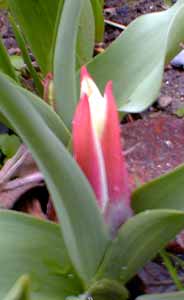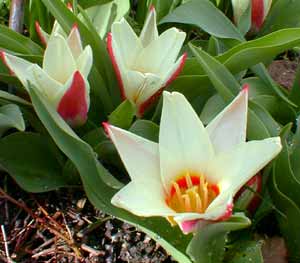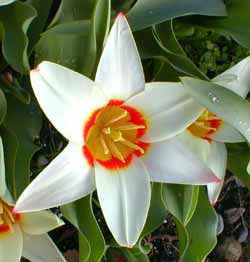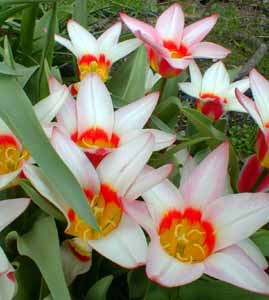
'Ancilla'
Waterlily Tulip
"In gardens let Zor'aster's worship
again with all its rites revive,
While now within the tulip's blossoms
the fires of Nimrod are alive. "
-Hafiz
(1325-1389)
(1325-1389)
Tulipa kaufmanniana 'Ancilla,' a recipient of the Award of Garden merit, was introduced to gardening in 1955 by the Dutch grower C. G. van Tubergen, in the first great wave of kaufmanniana cultivars to reach the public.
It is a miniature botanical hybrid, though it is "miniature" only in terms of height. It has large flowers on very short stems, reaching around eight inches.
 This cultivar comes very close to the original wild form kaufmanniana in appearance in that it has fat plain green leaves. Many kaufmannianas lack the clear leaves, but instead have mottled or red-striped leaves (such as does T. kaufmanniana 'Heart's Delight'). Such striping reveals the influence of either incidental or intentional hybridization with T. greigii.
This cultivar comes very close to the original wild form kaufmanniana in appearance in that it has fat plain green leaves. Many kaufmannianas lack the clear leaves, but instead have mottled or red-striped leaves (such as does T. kaufmanniana 'Heart's Delight'). Such striping reveals the influence of either incidental or intentional hybridization with T. greigii.'Ancilla' varies from the wild form (which is creamy yellow with a yellow heart, & rosy blush on the outside) in that the leaves are wavy for 'Ancilla' & the flower is larger with a bright zone of red circling the yellow heart. The interior white also ages with a pink blush, which the wild form does not, & the outer petals become redder as the month progresses.
All kaufmannianas perennialize excellently, but most that are hybridized do not naturalize by self-seeding in the way that the wild form does. 'Ancilla' will not self-seed, but if left undisturbed will return each late winter or early spring, producing flowers for years & years.
 They get the name "waterlily type" not for any requirement for extra watering but because when the flowers are fully mature on a very sunny day, they open flat, & then look a bit like waterlilies.
They get the name "waterlily type" not for any requirement for extra watering but because when the flowers are fully mature on a very sunny day, they open flat, & then look a bit like waterlilies.Waterlily tulips are earliest to bloom, starting late winter or right on the cusp of spring, & lasting into April. The first photo above was taken on the first day of March (2004); this was the first 'Ancilla' to appear, the rest to follow soon after.
The second photo from a couple days later shows the outer petals becoming increasingly red, & the inner petals still primarily the same creamy yellowish white as the wild form. The third blossom portrait shows it fully reflexed in its famous "water-lily" aspect, the creaminess having faded to ivory white, & most of the red blush hidden underneath the flattened petals except for a tiny bit of red visible at the tippy-tip of each petal, & of course the colorful heart.
The transformation of the palest pale yellow of the petals to nearly white is only the beginning, as it continues to change through the month, until the interior has a pink blush, which is just beginning to show in the fourth photo about mid-March. The progression from creamy yellow, to ivory, to pink blush, makes this variety intensely interesting day by day.
 When 'Ancilla' is fully opens in bright sun, the color-changes that the interior of the star-shaped flower is going through can be closely watched & appreciated, with only the ring of red in the inside center remaining the same throughout the month. On cloudy days when it only partially opens, the outer petals are more visible, showing a sweet soft pink that also darkens through the month of March. Generally by the last day of March there won't be but a couple straggling blossoms left on any of the Kaufmannianas.
When 'Ancilla' is fully opens in bright sun, the color-changes that the interior of the star-shaped flower is going through can be closely watched & appreciated, with only the ring of red in the inside center remaining the same throughout the month. On cloudy days when it only partially opens, the outer petals are more visible, showing a sweet soft pink that also darkens through the month of March. Generally by the last day of March there won't be but a couple straggling blossoms left on any of the Kaufmannianas.We planted eighteen 'Ancilla' bulbs in front of eighteen 'Aladdin' hybrid lily-tulips, as the 'Aladdin' can be twice as tall yet shares with the kaufmannianas the pointed petals. The location is in well-draining soil in bright sun in front of a Beauty Berry bush. To the left of these two tulips are the short 'Heart's Delight' waterlily tulips, in front of the equally pointy-petalled but considerably taller T. retroflexa 'Ballerina.'
'Ancilla' means a "Handmaiden." Roman funerary inscriptions sometimes designated a deceased woman as Ancilla Dei, which is to say, Handmaiden of God. There arose a Christian belief that historical & legendary saints & consecreated virgins were buried in tombs thus designated Ancilla Dei, & it is from this tradition that the tulip cultivar takes its name.
But 'Ancilla' originally had no Christian context, even though possibly adapted very early by the primitive church, & afterward preserved as a Catholic title designating nuns or even the Virgin Mary herself as Maria Ancilla. Hence anyone whose alma mater happens to be Ancilla College, Indiana, is pretty much guaranteed to be a Catholic.
Nevertheless, in Rome itself, by the time of Emperor Claudius, Ancilla designated a Roman matron who cohabited with a slave, & so herself fell to the status of Handmaiden or slave rather than a Roman citizen.